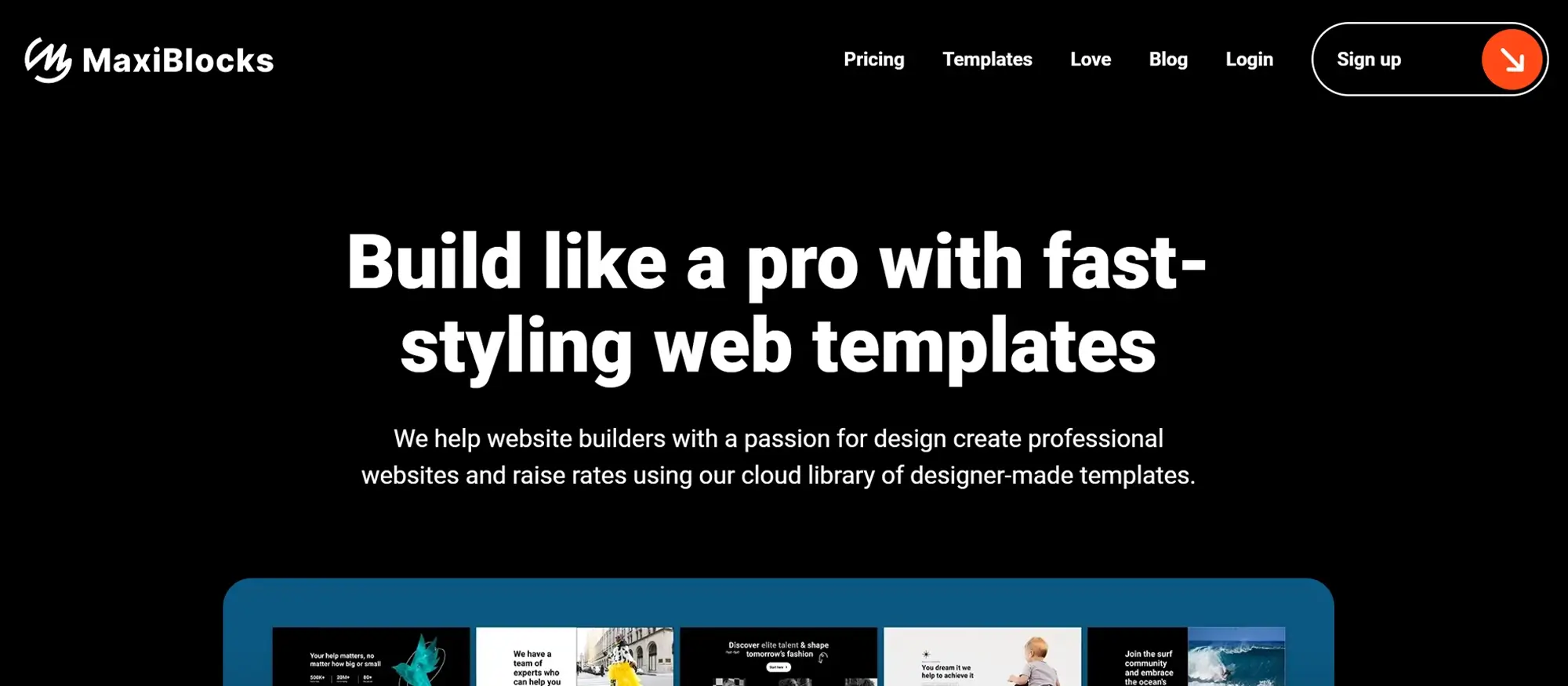20 Different Types of WordPress Services
Try MaxiBlocks for free with 500+ library assets including basic templates. No account required. Free WordPress page builder, theme and updates included.

Updated 15th May 2025
Key WordPress services and how they support your website
Getting the right help for setup, design, and functionality
WordPress powers millions of websites across different industries due to its flexibility and ease of use. Whether you’re launching a new site or enhancing an existing one, the right services can help you achieve your goals more effectively. From installation to custom design and plugin development, understanding what’s available allows you to choose services that match your specific needs.
WordPress installation and setup
The first step in building your WordPress site is proper installation and configuration. This process includes downloading WordPress, uploading it to your hosting server, and running the initial setup script. During this stage, you’ll set important site details like the title, tagline, and admin login credentials. A smooth setup creates a reliable foundation for your website and ensures that future development goes as planned.
Custom theme development for unique branding
Customising the visual style of your site through theme development helps establish a strong online presence. You can either create a new theme from scratch or adapt an existing one to suit your branding and functionality needs. A well-developed theme supports your business identity, improves usability, and gives your site a distinct look that separates it from others using off-the-shelf designs.
Extending functionality with plugin development
Plugins allow you to add features beyond the core WordPress capabilities. While many ready-made plugins are available, developing custom plugins ensures that functionality is tailored to your exact requirements. Whether it’s a contact form, advanced SEO tools, or integration with third-party services, custom plugin development adds flexibility and control to your website.
Designing a user-friendly WordPress website
Effective website design is about more than aesthetics. It involves structuring content in a way that’s easy to navigate and visually clear across all devices. Layout elements such as headers, footers, and menus must be arranged thoughtfully to guide users and improve their experience. A good design not only makes your site look professional but also enhances accessibility and engagement.

WordPress services for site maintenance, security, and performance
Keeping your website secure, fast, and visible online
Maintaining a WordPress site goes far beyond the initial design and launch. Ongoing services such as maintenance, security, performance optimisation, and SEO are key to ensuring that your website remains secure, runs efficiently, and ranks well in search engines. These services help support your site’s success over the long term.
WordPress website maintenance for long-term reliability
Maintaining your WordPress website involves routine tasks that keep it running smoothly. This includes updating core software, plugins, and themes to protect against security vulnerabilities and compatibility issues. Regular backups are also crucial to prevent data loss in case something goes wrong. By staying on top of maintenance, you reduce the risk of downtime and keep your site performing at its best.
Securing your WordPress site against threats
WordPress security services help protect your website from cyber attacks and malicious activity. This involves using security plugins, updating software regularly, enabling firewalls, and conducting periodic scans. Proactive security management helps you avoid data breaches, malware, and other risks that could compromise your site and your users.
Boosting performance with optimisation techniques
Website performance plays a major role in user experience and search rankings. WordPress performance optimisation includes tasks like compressing images, minimising code, and using caching tools to speed up page loading times. A fast site not only keeps visitors engaged but also improves your visibility in search engines by meeting performance standards.
Improving visibility with WordPress SEO services
Search engine optimisation is essential for helping your website attract organic traffic. SEO services for WordPress typically involve refining your content with relevant keywords, writing effective meta descriptions, improving page structure, and building backlinks. These efforts help search engines understand your site better and can lead to higher rankings over time.
Subscribe to our newsletter
Advanced WordPress services for content, commerce, and site management
Supporting growth with content tools, e-commerce features, and site migration
As your WordPress site evolves, you may need more advanced services to manage content efficiently, set up an online store, run multiple websites, or move your site between hosting environments. These services add flexibility and help scale your site while maintaining stability and user experience.
Managing content with structure and clarity
Content creation and management are central to maintaining an engaging and informative website. WordPress offers built-in tools to organise your content using categories, tags, and custom post types. Proper organisation not only helps visitors find information easily but also improves your site’s SEO and usability. A well-structured content strategy supports ongoing updates and keeps your site relevant.
Creating a functional online store with WordPress
WordPress supports full e-commerce functionality through plugins like WooCommerce. These tools allow you to manage product listings, process payments, handle shipping, and maintain customer records. Whether you’re selling physical goods, digital downloads, or subscriptions, a customised e-commerce setup can turn your site into a fully operational shop tailored to your business needs.
Running multiple sites with WordPress multisite
For businesses or organisations managing multiple websites, WordPress multisite offers a way to control everything from one central dashboard. This setup is ideal for networks of related sites, such as regional branches or sub-brands. It involves configuring individual site settings, managing user roles, and ensuring consistent updates and security across all sites in the network.
Moving your site with professional migration services
WordPress migration is the process of moving your site between servers or environments. This might be necessary when switching hosting providers or launching a site that was developed locally. A successful migration involves transferring files, updating databases, and testing functionality to avoid issues like broken links or downtime. Proper handling of this process helps maintain your site’s performance and structure without disruption.

Customisation, hosting, analytics, and support for your WordPress site
Enhancing performance and usability through tailored services
WordPress offers a flexible framework that supports a wide range of features and functionality. To get the most out of your site, additional services such as customisation, specialised hosting, performance tracking, and user support can play a crucial role. These services help ensure that your website is fast, reliable, and easy to manage.
Customising your WordPress site to match your needs
WordPress customisation involves adapting themes and plugins to better suit your goals. This can include changing the layout, adjusting design elements, or adding new features that aren’t part of the default setup. Customisation allows you to fine-tune your website’s appearance and functionality, making it more aligned with your brand and the needs of your audience.
Choosing the right WordPress hosting solution
The performance and stability of your WordPress site depend on the quality of your hosting. Options like shared hosting, virtual private servers (VPS), and dedicated servers offer different levels of speed, security, and scalability. Selecting the right hosting provider ensures that your site loads quickly, handles traffic efficiently, and remains online without interruption.
Using analytics to understand and improve performance
Analytics tools give you a clear view of how people interact with your website. You can track visitor behaviour, see which pages are performing well, and understand where your traffic is coming from. This data helps guide content updates, design changes, and marketing efforts, allowing you to make strategic decisions based on real user activity.
Empowering users through training and support
Training and support services help users gain confidence in managing their WordPress websites. This may include guided sessions, video tutorials, or ongoing technical support. Whether you’re learning how to update content, adjust settings, or solve common issues, proper training makes day-to-day management easier and more efficient.
Build like a pro
Expert-level WordPress services for strategy, accessibility, and mobile experience
Expanding your site’s impact with advanced development and support
As your WordPress website grows, expert-level services can help you refine its strategy, migrate from other platforms, improve accessibility, and optimise mobile performance. These specialised offerings ensure your site is well-equipped to meet modern standards and user expectations.
Expert guidance through WordPress consultation services
WordPress consultation services offer tailored advice on how to make the most of your website. Consultants help evaluate your site’s design, structure, and functionality, offering practical recommendations based on your goals. Whether you’re planning a redesign, troubleshooting an issue, or improving performance, expert input ensures that your decisions are strategic and effective.
Migrating to WordPress from other platforms
Moving your site from another platform to WordPress involves careful data transfer and content adaptation. This includes mapping old content to WordPress structures, setting up categories, adjusting URLs, and preserving SEO value. A well-managed migration ensures that your content fits seamlessly into the WordPress environment without losing functionality or data integrity.
Making your website accessible to all users
Accessibility services help make your WordPress site usable for people with disabilities by following recognised standards such as WCAG. This includes adding alternative text for images, ensuring screen reader compatibility, and improving keyboard navigation. Accessibility is not only a legal consideration it also broadens your audience and improves the overall user experience.
Building WordPress websites optimised for mobile devices
With more users accessing websites on mobile, mobile-first development is essential. This includes responsive design that adjusts to various screen sizes, touch-friendly navigation, and fast-loading elements. WordPress mobile development ensures your site performs well across smartphones and tablets, improving engagement and meeting modern browsing expectations.

Final thoughts and key takeaways
When considering WordPress services, it’s important to understand the wide range of options available to help you build, manage, and optimise your website. From custom theme design and plugin development to SEO optimisation and ongoing maintenance, these services can significantly enhance your site’s performance and user experience. Whether you’re creating a simple blog or a complex e-commerce site, choosing the right services ensures your website functions efficiently and securely.
For those seeking a flexible and easy-to-use WordPress theme, MaxiBlocks offers a powerful solution that simplifies customisation and enhances design capabilities, making it an excellent choice for building a professional website.
Exploring the right WordPress web design company for your business
When it comes to building a professional and results-driven website, choosing a WordPress web design company can make all the difference. Whether you’re partnering with a WordPress web design studio for creative input or a WordPress web design agency for full-service delivery, aligning your project with the best WordPress design approach is essential. A strong offering of WordPress design services will typically include plugin selection, SEO, and performance optimisation.
Ensuring your site is hosted on the best website hosting for WordPress improves speed and uptime, while choosing the right WordPress plugins enhances its functionality. For those seeking hands-on guidance, the WordPress website designer guide is a useful resource. To maximise reach and efficiency, focus on how to optimise WordPress SEO, make the most of Google Analytics for WordPress, and continuously work on optimising WordPress for better performance.
Discover tools and layouts used by the best web designers
Explore expert tips, tools, and creative examples that define today’s best web designers.
FAQs – 20 Different Types of WordPress Services
What is WordPress theme customisation?
WordPress theme customisation involves modifying a pre-existing theme to better match your brand’s look and functionality requirements. This includes changes to layout, colours, fonts and other visual elements.
What is custom WordPress development?
Custom WordPress development refers to building unique themes or plugins from scratch to meet specific business needs that are not covered by standard options.
What is WordPress website maintenance?
Website maintenance includes regular updates to WordPress core, themes and plugins, as well as backups, security scans and performance checks to keep the site running smoothly.
What is WordPress plugin development?
This service involves creating bespoke plugins to add specific features or functionality to your website that cannot be achieved with existing plugins.
What is WooCommerce integration?
WooCommerce integration is the process of adding e-commerce functionality to your WordPress site so you can sell products or services online.
What is WordPress SEO optimisation?
This service focuses on improving your website’s visibility in search engines through on-page SEO techniques, keyword optimisation and performance enhancements.
What is WordPress security hardening?
Security hardening includes implementing measures such as firewalls, malware scans, login protection and regular updates to reduce the risk of hacks and vulnerabilities.
What is WordPress speed optimisation?
Speed optimisation involves improving your site’s loading time by compressing images, minimising scripts and enabling caching, all of which enhance user experience and SEO.
What is WordPress migration?
Migration is the process of moving a WordPress website from one host or domain to another without losing data or affecting performance.
What is WordPress backup and restore?
This service ensures your website is regularly backed up and can be restored quickly in case of a crash, hack or error.
What is WordPress website redesign?
A redesign updates the look, layout and functionality of an existing WordPress site to improve usability, modernise the brand and boost performance.
What is WordPress multisite setup?
Multisite setup allows you to manage multiple WordPress sites from a single dashboard, which is useful for franchises, networks or organisations with multiple brands.
What is WordPress training and support?
Training services help you learn how to manage your WordPress website, while support provides ongoing help with troubleshooting, updates and content management.
What is WordPress API integration?
This service involves connecting your WordPress site to external systems such as CRMs, payment gateways or booking platforms using APIs.
What is WordPress content management?
Content management services include adding, updating and organising content such as blog posts, pages, images and downloads on your website.
What is WordPress hosting setup?
This involves configuring your web hosting environment to support WordPress, including installing the platform, setting up domains and ensuring compatibility.
What is WordPress website audit?
An audit analyses the performance, SEO, security and structure of your website to identify areas for improvement and provide actionable recommendations.
What is WordPress bug fixing?
This service addresses and resolves errors, glitches or broken features within your WordPress website, ensuring everything functions correctly.
What is WordPress multilingual setup?
Multilingual setup allows your site to offer content in multiple languages using plugins or custom solutions, ideal for reaching international audiences.
What is WordPress consultation?
Consultation services offer expert guidance on strategy, design, development and performance improvements to help you get the most from your WordPress website.
WordPress itself
Official Website
wordpress.org – This is the official website for WordPress, where you can download the software, find documentation, and learn more about using it.
WordPress Codex
codex.wordpress.org/Main_Page – This is a comprehensive documentation resource for WordPress, covering everything from installation and configuration to specific functionality and troubleshooting.
WordPress Theme Directory
wordpress.org/themes – The official WordPress theme directory is a great place to find free and premium WordPress themes. You can browse themes by category, feature, and popularity.
maxiblocks.com/go/help-desk
maxiblocks.com/pro-library
www.youtube.com/@maxiblocks
twitter.com/maxiblocks
linkedin.com/company/maxi-blocks
github.com/orgs/maxi-blocks
wordpress.org/plugins/maxi-blocks

Kyra Pieterse
Author
Kyra is the co-founder and creative lead of MaxiBlocks, an open-source page builder for WordPress Gutenberg.
You may also like

